Wozniacki Hot Streak Continues In Luxembourg
Caroline Wozniacki’s excellent run of form continued as she overcame Madison Brengle 6-2, 6-2 in the first round of the BGL BNP Paribas Luxembourg Open.
The Dane, who has lost just three matches since the US Open and won the Toray Pan Pacific Open and the Hong Kong Open in recent months, suffered a slow start to the match, dropping serve in the opening game.
However, Brengle’s lead was short-lived, with Wozniacki finding her range and winning six games in a row to take the set. She carried her good form into the second set, skipping into a 5-0 lead and though she dropped serve and was unable to complete the bagel, she recovered to book her place in the next round.
Top seed Petra Kvitova also cruised through her opening encounter, beating Su-Wei Hsieh 7-5, 6-0.
The two-time Wimbledon champion went ahead early, breaking the World No.81 in her second game but she was unable to consolidate her advantage. Hsieh had the chance to serve for the set at 5-4, but was broken to love and lost serve again when trying to force a tiebreak.
From then on, Kvitova was well on top and did not lose a single game in the second set.

Kristyna Pliskova had to battle from a set behind to beat Oceane Dodin 3-6, 6-3, 6-4.
The Czech broke in the opening game of the match but her advantage was short-lived as she saved seven break points before eventually succumbing to the pressure on the eighth. Dodin subsequently broke to love to move ahead and was able to serve out the set.
In a tight second set, Pliskova eventually went ahead in the penultimate game and held her nerve to level the match. After being broken in the first game of the decider, Dodin failed to get back on level terms and exited the tournament.
Meanwhile, Misaki Doi’s defence of her Luxembourg title came to a premature end at the hands of American qualifier Lauren Davis, who emerged with a highly creditable 6-1, 6-2 victory.
The No.6 seed never found her feet and slipped to a 4-0 deficit before she won her only game of the first set.
She began the second in better form, moving a break up in the first game but she soon four successive games. Davis made no mistake from there and the World No.85 emerged from the match with a famous scalp.
Kiki Bertens had no such problems in progressing, though she had to overcome a plucky Annika Beck to secure her 6-4, 6-4 victory.
The Dutchwoman had led 5-2 and seemed to be cruising in the first set but the German got back on terms, only to lose her serve once more. Bertens let a break slip again in the second set but, with Beck serving to stay in the match, the No.3 seed broke to book her place in the second round.
Meanwhile, Mona Barthel cruised past Carina Witthoeft 6-1, 6-4, Johanna Larsson brushed Pauline Parmentier aside 6-4, 6-2, Tereza Smitkova defeated Sorana Cirstea 6-3, 6-3 and Andrea Petkovic survived a scare to defeat Mandy Minella 1-6, 7-5, 6-4.





